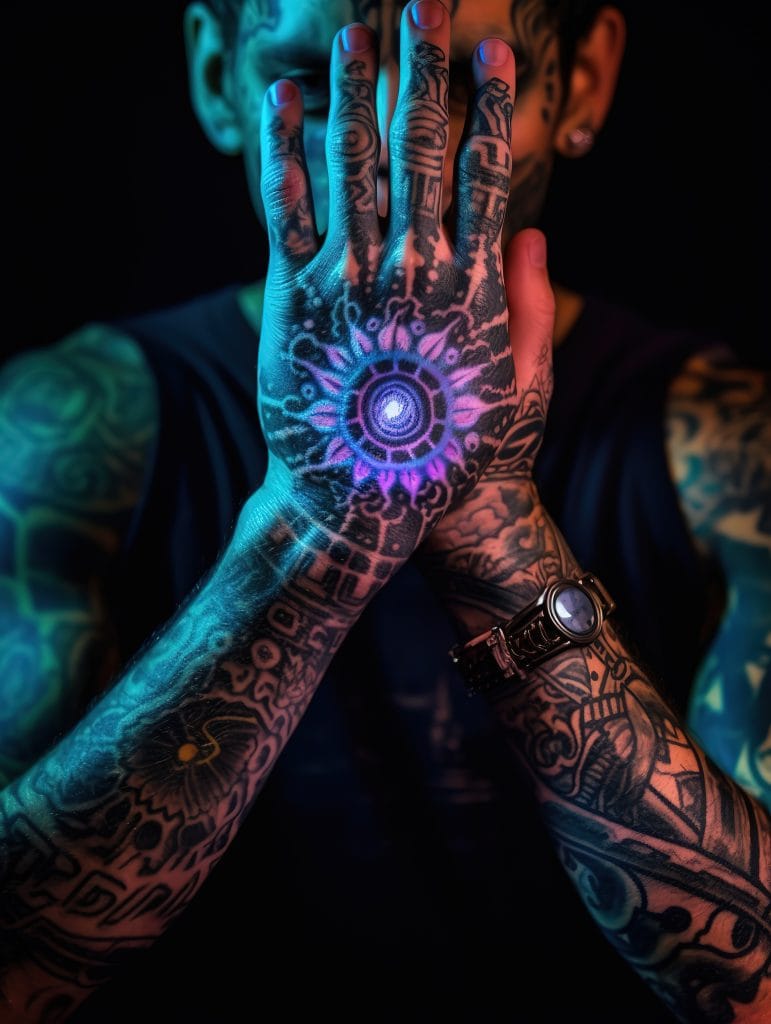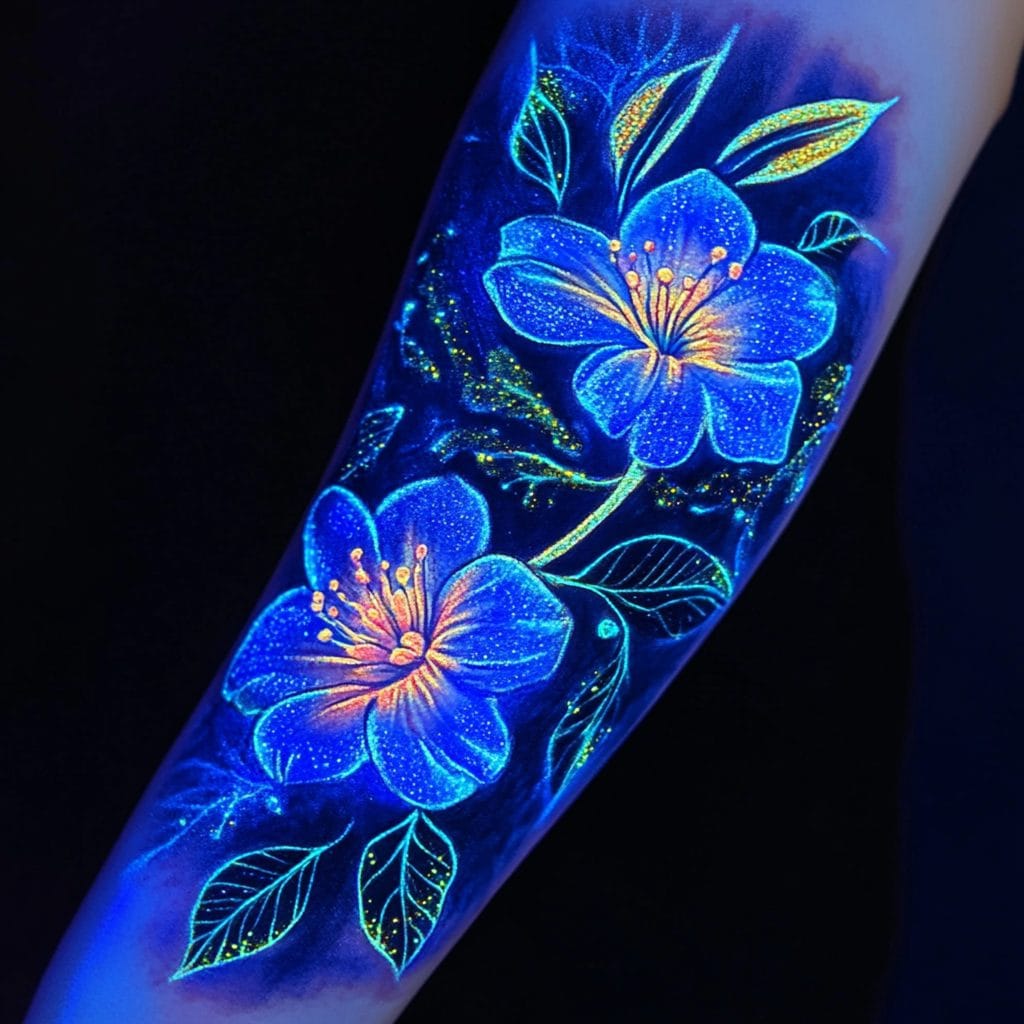UV-reactive tattoos, often referred to as blacklight tattoos, are a unique form of body art that utilizes special inks designed to glow under ultraviolet light. These tattoos are typically invisible or only faintly visible in natural light, making them an intriguing choice for those who want a more discreet form of self-expression. The inks used in these tattoos contain phosphorescent materials that react to UV light, creating a vibrant glow that can be quite striking in the right setting.
This characteristic makes them particularly popular among individuals who frequent nightclubs, raves, or other environments where blacklight is prevalent. The appeal of UV-reactive tattoos lies not only in their aesthetic but also in their ability to offer a sense of personal uniqueness. Many people are drawn to the idea of having a tattoo that can be hidden in plain sight, only revealing its true colors under specific lighting conditions.

This duality allows for a more versatile approach to body art, as individuals can choose to showcase their tattoos or keep them concealed based on their preferences or the occasion. As the popularity of these tattoos continues to grow, so does the variety of designs and styles available, making them an exciting option for those looking to express themselves in a novel way.
Key Takeaways
- UV-Reactive (Blacklight) tattoos are tattoos that are only visible under ultraviolet light, giving them a glowing effect.
- Safety concerns for UV-Reactive tattoos include potential allergic reactions to the ink and the unknown long-term effects of the UV-reactive ink on the skin.
- UV-Reactive tattoos may fade faster than traditional tattoos due to the nature of the UV-reactive ink and its reaction to sunlight.
- Design ideas for UV-Reactive tattoos can include intricate patterns, geometric shapes, and bold, vibrant colors that will pop under blacklight.
- Choosing the right artist for UV-Reactive tattoos is crucial, as not all tattoo artists are experienced or comfortable working with UV-reactive ink.
Safety Concerns and Risks of UV-Reactive Tattoos
While UV-reactive tattoos offer a unique aesthetic, they also come with certain safety concerns that potential clients should consider. One of the primary issues is the composition of the inks used in these tattoos. Many UV-reactive inks contain pigments that may not be approved for use in cosmetic applications.
This raises questions about the potential for allergic reactions or skin irritations, particularly for individuals with sensitive skin or pre-existing conditions. It is crucial for anyone considering a UV-reactive tattoo to conduct thorough research on the inks being used and to consult with a professional tattoo artist who is knowledgeable about the materials involved. Another significant concern is the long-term effects of exposure to UV light.
While blacklight tattoos are designed to glow under specific lighting conditions, prolonged exposure to UV rays can lead to skin damage over time. This is particularly relevant for individuals who may frequently expose their tattoos to blacklight environments. The risk of skin cancer associated with UV exposure is well-documented, and it is essential for tattoo enthusiasts to weigh the aesthetic benefits against potential health risks.
Consulting with a dermatologist before getting a UV-reactive tattoo can provide valuable insights into personal risks and help individuals make informed decisions.
Longevity of UV-Reactive Tattoos: Do They Fade Faster?
One common question surrounding UV-reactive tattoos is their longevity compared to traditional tattoos. The fading of tattoos over time is influenced by various factors, including ink quality, skin type, and exposure to sunlight. Generally speaking, UV-reactive inks may fade faster than conventional tattoo inks due to their chemical composition.
The phosphorescent materials that create the glowing effect can break down more quickly when exposed to sunlight or harsh environmental conditions. As a result, individuals with UV-reactive tattoos may find that their designs require more frequent touch-ups to maintain their vibrancy. Additionally, the placement of the tattoo can also impact its longevity.
Areas of the body that are more exposed to sunlight or friction may experience faster fading than those that are more protected. For instance, a tattoo on the forearm may fade more quickly than one located on the upper back. To maximize the lifespan of a UV-reactive tattoo, it is advisable to follow proper aftercare practices and limit sun exposure as much as possible.
Regular moisturizing and using sunscreen on exposed areas can help preserve the integrity of the tattoo and keep it looking fresh for longer.
Design Ideas for UV-Reactive Tattoos
When it comes to design ideas for UV-reactive tattoos, the possibilities are virtually limitless. Many individuals opt for intricate patterns or abstract designs that can take full advantage of the glowing effect under blacklight. Geometric shapes, mandalas, and tribal motifs often translate beautifully into UV-reactive ink, creating stunning visual contrasts between light and dark.

Additionally, floral designs can also be enhanced with UV-reactive elements, allowing for a vibrant display that comes alive in specific lighting conditions. Another popular choice for UV-reactive tattoos is incorporating elements from pop culture or personal interests. For example, fans of science fiction or fantasy may choose designs inspired by their favorite movies or books, using glowing elements to highlight key features or symbols.
Additionally, many people opt for text-based designs that feature meaningful quotes or phrases, which can take on a new dimension when illuminated by blacklight. Ultimately, the key to a successful UV-reactive tattoo design lies in collaboration with a skilled artist who understands how to effectively use color and light to create a captivating piece of art.
Choosing the Right Artist for UV-Reactive Tattoos
Selecting the right artist for a UV-reactive tattoo is crucial to ensuring both safety and quality. Not all tattoo artists have experience working with UV-reactive inks, so it is essential to seek out someone who specializes in this type of body art. A skilled artist will not only have a deep understanding of the materials involved but will also be able to provide guidance on design choices and placement based on their expertise.
When researching potential artists, it is advisable to review their portfolios and look for examples of previous UV-reactive work. In addition to artistic skill, it is important to consider hygiene practices and overall professionalism when choosing an artist. A reputable tattoo studio should adhere to strict sanitation protocols and use high-quality inks that are safe for skin application.
During consultations, potential clients should feel comfortable asking questions about the inks being used and any safety measures in place. Building a rapport with the artist can also enhance the overall experience, as open communication is key to achieving a desired outcome.

Aftercare and Maintenance of UV-Reactive Tattoos
Proper aftercare is essential for maintaining the vibrancy and longevity of UV-reactive tattoos. Immediately following the tattooing process, it is crucial to follow the artist’s aftercare instructions closely. This typically includes keeping the area clean and moisturized while avoiding direct sunlight and soaking in water for an extended period.
Using a gentle, fragrance-free soap and applying a suitable healing ointment can help promote optimal healing conditions. Once the initial healing period has passed, ongoing maintenance becomes important for preserving the tattoo’s appearance. Regular moisturizing can help keep the skin hydrated and prevent dryness, which can contribute to fading over time.
Additionally, applying sunscreen on exposed areas can protect against harmful UV rays that may cause both skin damage and fading of the tattoo’s colors. By taking these steps, individuals can ensure that their UV-reactive tattoos remain vibrant and eye-catching for years to come.
UV-Reactive Tattoos: Are They Right for You?
Deciding whether a UV-reactive tattoo is right for you involves careful consideration of personal preferences and lifestyle factors. For those who enjoy nightlife or environments where blacklight is prevalent, these tattoos can serve as an exciting form of self-expression that stands out in unique ways. However, individuals who prefer more traditional forms of body art may find that UV-reactive tattoos do not align with their aesthetic values.
It is also important to consider potential health risks associated with UV-reactive inks and exposure to UV light. Those with sensitive skin or allergies may want to approach this type of tattoo with caution and consult with medical professionals before proceeding. Ultimately, understanding your own preferences and lifestyle will help guide your decision-making process when it comes to choosing a UV-reactive tattoo.
The Future of UV-Reactive Tattoos
As body art continues to evolve, UV-reactive tattoos represent an exciting frontier in self-expression and creativity. With advancements in ink technology and growing awareness about safety practices, these tattoos are likely to gain even more popularity in the coming years. Artists are continually experimenting with new designs and techniques that push the boundaries of what is possible with UV-reactive ink, leading to innovative creations that captivate audiences.

The future of UV-reactive tattoos also holds promise in terms of customization and personalization. As more individuals seek unique ways to express themselves through body art, artists will likely develop new styles and approaches that cater specifically to this demand. Whether through intricate designs or bold statements, UV-reactive tattoos are poised to remain a vibrant part of the tattoo landscape for years to come, offering enthusiasts an opportunity to showcase their individuality in ways that are both visually stunning and deeply personal.
